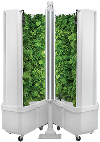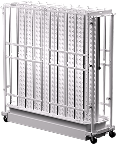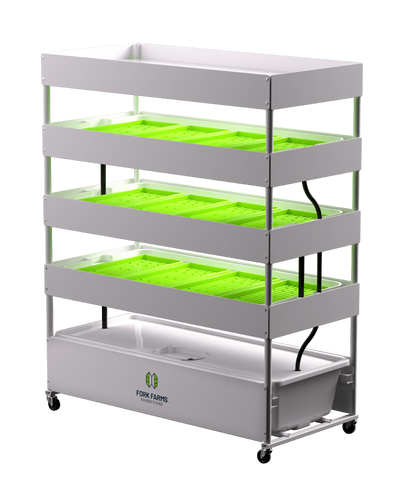4 Tell-Tale Signs You Need to Get a New Hydroponic Growing System
There are a lot of advantages to hydroponic growing systems, but if you’re struggling with your existing technology, it may not seem that way. However, depending on what’s wrong with your hydroponic growing system, there can be several ways to troubleshoot and improve your situation. While farmers and growers can fix some problems, more severe issues may require investing in a new hydroponic system. In this article, we’ll review common issues and when to consider trying a system that better suits your goals.
Common Hydroponic Garden Troubleshooting
Whether you’re getting started with hydroponics or trying to improve your hydroponic farming skills, one of the most essential things to evaluate is how often you’re checking in on your produce. One of the easiest ways to troubleshoot your hydroponic growing system and prevent issues is through observation and regular system monitoring. By keeping an eye on your plants and their progress, you can catch potential problems early to prevent adverse effects on their health.
However, if you’re past that point, some clear signs indicate you have unhealthy plants.
Diagnosing Unhealthy-Looking Plants In Your Hydroponic Growing System
When diagnosing unhealthy-looking plants, some early indicators include yellow leaves, spots on leaves, tip burn, and stagnant growth.
A few potential causes for these issues include:
- The plants are not receiving adequate nutrients and/or light. Ensure you follow the recommended pH (5.5-6.5) and nutrient levels. The water might be inundated with nutrients, and a refresh might be necessary. Additionally, use the correct LED lighting to ensure that plants receive enough light during the day.
- Unbalanced airflow, temperature, and humidity. While plants need a variety of environmental factors to grow, an imbalance may be contributing to poor performance. Maintaining humidity levels between 40-70% and temperatures between 60-80 degrees F is good, and increasing the airflow around the plants helps the plants breathe (increasing their nutrient uptake).
- LED lights are not turning on. If the lights are plugged directly into the wall (without the timer), and none of the LEDs turn on, or they flicker, there could be a few culprits:
- Low-quality LED lights. Some LED lights are made from inferior materials, have a short lifespan, and provide insufficient light. If the lights are mounted too high or too low for plants, it may impact growth. If you mount the LEDs too high, the bulb’s intensity will be reduced. If the plants are mounted too low, you might damage the plants.
- Water damage. Water could have splashed into the LED plugs, causing the GFCI to activate. This will shut off power to the LEDs until the plugs are dry.
4. Water flow is disrupted or has stopped. If the hydroponic grow medium is dry, the plants are wilting, and/or the water pump is struggling to run, there are a few potential causes
- Clogged irrigation lines. Follow the water flow in your system to pinpoint if there is plant debris or a kink in your irrigation lines. Low-quality or poorly installed irrigation lines are more prone to clogs.
- The pump disconnected from irrigation. Check to make sure there is a tight connection.
- Pump failure. If the hydroponic system runs too long without adequate water, it will cause the pump to fail. Inferior pumps also will fail more quickly and require replacement.
While some of these issues may be caused by inexperience, many relate to having an ineffective or outdated hydroponics system.
Curious for more? Check out the 6 most common mistakes in indoor hydroponic gardening.
Constantly Troubleshooting Your Hydroponic Farm: What’s the Answer?
If you find yourself troubleshooting constantly, it may be time to determine whether or not you need a new hydroponic system. Deciding whether a hydroponic growing system is the best fit involves various factors, such as:
- Your personal goals for growing
- Your budget and financial goals
- Your availability and time commitment
- Ongoing maintenance considerations
If you constantly have dead or unhealthy plants, excess build-up, and debris or replacing parts, consider an alternative system.
New Hydroponic Farm Checklist
With effective hydroponic technology, farmers and growers can access healthy and nutritious produce year-round. In our experience, this technology typically includes:
- Minimal assembly time (it shouldn’t take hours or days to assemble!)
- Warranty on equipment
- High-quality product materials
- Easy to understand growing instructions and nutrient/pH dosing
- Availability of support resources and accessible customer service
Our Flex Farm, capable of growing more than 394 pounds of produce annually, is an example of a flexible and cost-effective system to help you grow and scale your growth efforts.
Getting Started with the Flex Farm
An innovative hydroponic system can solve many of your problems, but staying consistent with hydroponic farming is key in the long run. In addition to staying up-to-date with the latest in agricultural technology, we’ve created a community of other farmers and growers finding success with hydroponic farming.
Ready to learn more? Explore our Flex Farm and farming community today!
Important Links:
























